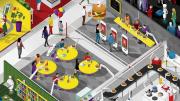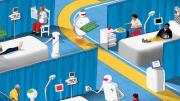Robots And Computers Could Take Half Our Jobs Within the Next 20 Years”…“Robots Could Put Humans Out of Work by 2045”…“White House Predicts Robots May Take Over Many Jobs That Pay $20 Per Hour”…“Robot Serves Up 360 Hamburgers Per Hour”…“Why the Highest-Paid Doctors Are the Most Vulnerable to Automation”…“Robot Receptionist in Tokyo Department Store.”
These headlines have the flavor of yellow journalism. But they are based on the predictions of researchers across many disciplines and on technological advances developed by firms large and small. The “half our jobs” figure comes from Oxford social scientists. The “out of work by 2045” prediction comes from a prominent computer scientist. Reports of machines competing with humans in hamburger flipping, highly paid medical work, and administrative tasks are the tip of the iceberg: robots may substitute for humans in virtually every domain. If computers can beat humans in Jeopardy, chess, and Go, it should be no surprise that they will soon be able to do many of our jobs as well as we can. But whether robotization will be good or bad for society isn’t a foregone conclusion—it will depend crucially on how public policy and private firms respond.
Machines and jobs
Preparing for a driverless car robo-lution, the National Highway Traffic Safety Administration (NHTSA) declared this year that because new self-driving vehicles “will not have a ‘driver’ in the traditional sense that vehicles have had drivers during the last more than 100 years,” the government will consider the software, not a human, to be controlling the vehicle. If you are one of 4.1 million motor-vehicle operators in the United States, including truck drivers, taxi drivers, and bus drivers, or a part-time Uber or Lyft driver, the self-driving vehicles are coming for your work.
Major auto companies are investing billions of dollars in driverless-car technology. General Motors and Lyft have announced a partnership in which GM will build an autonomous fleet of cars for the next-generation taxi business. Working with Google engineers, Ford has made development of driverless technology a central component of its business plan, and intends to bring self-driving vehicles to the mass market by 2020. Toyota expects to launch automated vehicles around 2020 as well. Given the advances of artificial intelligence, computerization, and robotics in every nook and cranny of the labor market, be prepared to hear NHTSA-style predictions about other lines of work in the not-so-distant future: your job may no longer be performed by a human. The software will be in charge.
Is this a legitimate worry, or a groundless fear? Most economists are in the latter camp. The standard analysis of technical change recognizes that machines may reduce employment in some occupations, but suggests that the fear of permanent displacement of human labor is ill-placed. Humans have always shifted away from work that’s been turned over to machines, to move into jobs more suitable for them, the argument goes, and there is no reason to expect the species to be less adept in the future.
From the 1930s through the 1990s, fears that technological advances would create permanent joblessness—which seemingly arise whenever unemployment persists for a long period—have proven groundless. In his 1940 State of the Union address, President Franklin Roosevelt blamed high unemployment on the nation’s failure to “[find] jobs faster than invention can take them away,” but when demand ramped up during World War II, the surplus of labor turned into a shortage. In the early 1960s, fears that automation would eliminate thousands of jobs per week led the Kennedy administration to examine the link between productivity growth and employment, but the late 1960s boom ended the automation scare. During the mid-1990s recession, some analysts proclaimed the end of work, only to see the dot-com boom raise the proportion of the adult population working to an all-time high. Employment returns when the economy recovers. And mechanization and automation have been accompanied by an improvement in the structure of jobs, with humans shifting from manual work to professional and managerial work. In the past several decades, the ratio of employment to population has increased rather than decreased. Should this time be different?
The logic of comparative advantage, which underpins economists’ skepticism about a jobless future, suggests not. In international trade, comparative advantage explains why a highly productive country does not “steal” jobs from a less productive country: instead, both countries benefit by specializing in sectors in which they have a relative advantage. Comparative advantage tells us that even in a world where robots outperform humans in all work activities, work will remain for humans in areas in which humans have a comparative advantage. Robots will be deployed in activities in which they have the relatively greatest productivity, while humans will work in fields where they have the smallest disadvantage. If a robot is twice as efficient as a human at driving cars, for example, but only 50 percent more efficient at picking blueberries, the robot would do the driving, while the human would pick the berries. The result would be greater total output than if some robots picked blueberries instead of driving cars, even though robots are better than humans at both tasks.
What comparative advantage does not guarantee, however, is that the jobs in which humans have an edge will provide good wages or working conditions. There is nothing that dictates that humans design and develop cars, while robots work on assembly lines building them. The allocation of work between humans and robots depends on their relative productivity, which in turn depends on the nature of technology—on the artificial intelligence algorithms and sensors and robotics that turn information into action. There is also nothing in economics that guarantees that the humans displaced from jobs by robots will end up with new jobs that pay as much as their former jobs, or pay enough to attain a middle-class lifestyle.
Still, past waves of mechanization and automation have been associated with higher labor productivity and wages, and have improved the quality of jobs. What, if anything, about the current wave of robotization and today’s job market makes the headlines about a jobless future a legitimate worry, rather than another episode of myopic fear?
Today’s robotization is not your parents’ automation
Enough is different about the economy and the application of artificial intelligence to justify worrying about the impact on jobs of robotization at a massive scale. The main thing to fear today is not joblessness, but a future in which the earnings of workers are stagnant or falling (as robots take a greater share of high-productivity jobs), and the share of income going to the owners of the machines increases.
In recent decades, the labor market has increasingly tilted against workers, producing levels of inequality that arouse global concern not just from traditional advocates of an egalitarian income distribution, but also from such staid organizations as the World Bank and the International Monetary Fund. Increases in worker productivity were once passed on proportionately to workers through gains in wages. Today, gains accrue disproportionately to the wealthy—who are the principal owners of capital. To make matters worse, labor’s share of national income, once roughly constant so that both workers and the owners of capital shared in the nation’s GDP growth, has been falling for the past two decades or so. Because capital is distributed more unequally than labor income, this trend furthers inequality. Meanwhile, the share of the work force in labor unions, which have historically bargained for higher wages and better benefits for workers, has been shrinking in the United States and most advanced countries, reducing pressure on management to increase wages commensurate with rising productivity.
On the technology side, the range of skills over which robots compete with humans has expanded from physical tasks to routine blue- and white-collar work and increasingly to the frontier of knowledge creation. Computer scientists have created algorithms that enable machines to learn on their own and advance their competence. Pedro Domingos, a computer scientist at the University of Washington, has predicted that “tomorrow’s scientists will have armies of virtual graduate students, doing lab work, statistical analysis, literature search, and even paper-writing.” Employers don’t care whether a robot can think and talk like a human, but whether it can do a job more cheaply than a human. The coming driverless-vehicle revolution will be mirrored by parallel changes across other sectors that will affect all of our lives in ways far beyond the usual incremental changes in technology.
The three laws of robo-nomics
Taking a leaf from Isaac Asimov’s famous three laws of robotics, I offer three laws of robo-nomics to guide our thinking about the way robotization will affect workers and the economy, and how that should inform policy.
Law 1: Advances in artificial intelligence and robotics will produce machines that are better substitutes for humans—in the lingo of economics, an increasing elasticity of substitution between robot and human work.
Law 2: The cost of robot machine substitutes for humans will decrease as technology reduces production costs, placing downward pressure on wages.
Law 3: Income will increasingly come from ownership of robots or other forms of capital and the stream of income they produce, rather than from human labor.
Robotization, like past technological changes, can be a very good thing, relieving the workload of humans while helping overcome the many challenges the world faces. But it could also affect humans diastrously, dividing societies between the owners of the robots on one side, and the workers who compete with the robots on the other. We should worry less about the potential displacement of human labor by robots than about how to share fairly across society the prosperity that the robots produce.
We should worry less about the potential displacement of human labor by robots than about how to share fairly across society the prosperity that the robots produce.
If the distribution of capital remains narrow, as it is now, the main beneficiaries of robotization would be a small number of wealthy owners, while the living standards of the vast majority of workers would suffer. That would exacerbate the growth of inequality, and risk producing a new robot-age feudalism, with workers captive to a small number of overlords who own robotic technology. If, to the contrary, people shared in the ownership of the machines that replace them at work, everyone’s freedom and living standards would improve. What policies can get us there?
The United States is uniquely situated to move its economy toward shared ownership. Many firms have profit-sharing or group-incentive pay structures, where employee earnings depend on the firm’s profitability. About 14 million workers work in firms that offer Employee Stock Ownership Plans, in which workers own part or all of the company through a retirement trust. Many other firms offer stock options. And many Americans own part of the nation’s business capital through pension funds and other investment vehicles.
These forms of compensation don’t currently give workers an ownership stake sufficient to ensure that the benefits of robotization will flow widely. But there is a menu of public and private policies that can: tax incentives for firms that give workers ownership shares, for example, and changes in corporate governance that increase workers’ say in the way new technologies are implemented. Last summer, presidential candidate Hillary Clinton proposed a modest tax break for firms that introduce profit-sharing for workers, which could signal the beginning of a post-robotization economic policy.
To help move discussion along, I have directed my robot assistant to develop a dynamic, nonlinear, computer simulation model to find the most effective way forward. With access to the newest super-computer, the robot will report shortly on what we should do.










